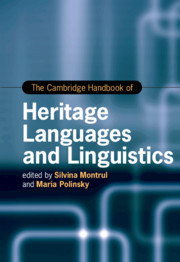Book contents
- The Cambridge Handbook of Heritage Languages and Linguistics
- Cambridge Handbooks In Language And Linguistics
- The Cambridge Handbook of Heritage Languages and Linguistics
- Copyright page
- Dedication
- Contents
- Figures and Tables
- Contributors
- Acknowledgments
- Introduction
- Part I Heritage Languages around the World
- 1 Slavic Heritage Languages around the Globe
- 2 Heritage Languages in Europe
- 3 Heritage Languages in Southeastern Europe
- 4 Heritage Languages in China
- 5 Heritage Languages in Japan and Korea
- 6 Heritage Languages in Israel
- 7 Heritage Languages in Aotearoa New Zealand and Australia
- 8 Heritage Languages in Canada
- 9 Asian Heritage Languages in the United States
- 10 The Vitality of Spanish as a Heritage Language in the United States
- 11 Germanic Heritage Varieties in the Americas
- 12 Arabic in North America
- 13 Heritage Languages in South America
- 14 Language Attrition and Heritage Language Reversal in Returnees
- Part II Research Approaches to Heritage Languages
- Part III Grammatical Aspects of Heritage Languages
- Part IV Heritage Language Education
- Index
- References
11 - Germanic Heritage Varieties in the Americas
Social and Linguistic Perspectives
from Part I - Heritage Languages around the World
Published online by Cambridge University Press: 04 November 2021
- The Cambridge Handbook of Heritage Languages and Linguistics
- Cambridge Handbooks In Language And Linguistics
- The Cambridge Handbook of Heritage Languages and Linguistics
- Copyright page
- Dedication
- Contents
- Figures and Tables
- Contributors
- Acknowledgments
- Introduction
- Part I Heritage Languages around the World
- 1 Slavic Heritage Languages around the Globe
- 2 Heritage Languages in Europe
- 3 Heritage Languages in Southeastern Europe
- 4 Heritage Languages in China
- 5 Heritage Languages in Japan and Korea
- 6 Heritage Languages in Israel
- 7 Heritage Languages in Aotearoa New Zealand and Australia
- 8 Heritage Languages in Canada
- 9 Asian Heritage Languages in the United States
- 10 The Vitality of Spanish as a Heritage Language in the United States
- 11 Germanic Heritage Varieties in the Americas
- 12 Arabic in North America
- 13 Heritage Languages in South America
- 14 Language Attrition and Heritage Language Reversal in Returnees
- Part II Research Approaches to Heritage Languages
- Part III Grammatical Aspects of Heritage Languages
- Part IV Heritage Language Education
- Index
- References
Summary
Continental West Germanic and North Germanic languages have been spoken in the Americas for several hundred years, and many are alive as heritage languages today, though often used only by elderly speakers. This chapter examines these languages from several perspectives. First, we look at social and historical contexts of bilingualism. Second, we describe the varieties used, e.g., the extent to which people knew a standard language, along with associated language attitudes and ideologies. Third, we look at key structural properties of Germanic heritage languages with examples from phonetics and phonology, morphology, syntax, pragmatics, and the lexicon, revealing parallels in development and change across languages. Finally, we note some patterns and language maintenance and shift.
Keywords
- Type
- Chapter
- Information
- The Cambridge Handbook of Heritage Languages and Linguistics , pp. 252 - 276Publisher: Cambridge University PressPrint publication year: 2021
References
- 2
- Cited by

